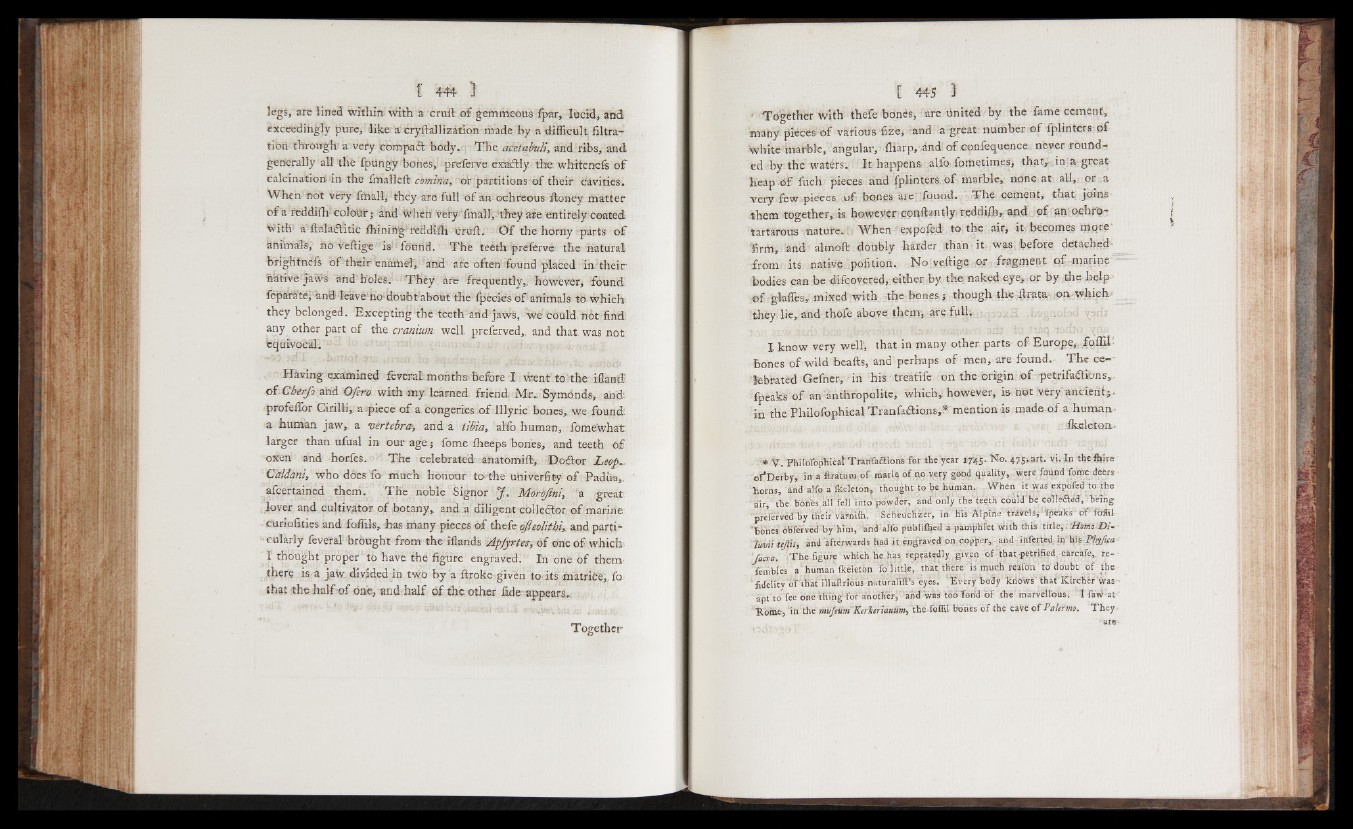
legs, are lined Within, with a cruft o f gemmeous fpar, lucid, and
exceedingly pure, like a cryftallizátion made by a difficult filtration
through'a very ‘compaCt body. The antabuli, and ribs, and
generally all thè fpüngy hones, preferve exaCHy tlie whitenefs oF
calcination in the fmalleft cornata, of partitions of their cavities.
When not very fmall, they are full o f an ochreous ftoney matter
o f a reddiili colour ; and When very fmall, they are entirely coated
With a ftalaflitic ihiniftg1 bèddìlh crüft. O f the horny parts o f
animals, hó veftigè is fo u n d . The teèth preferve the natural
brightnefs o f their enartiei, and afe often found placed in. their
hsri-ve jaws and holes. They áre frequently,; however, found
ieparste, and leave nodoaht about the fpecies o f animals to which1,
they belonged. 'Excepting‘the teeth arid’jaws, Wé-coüM not find
any other part of the cranium well preferved,. and that was not
equivocal.
Having examined feverai months before T went to the* iflan®
o f Cherfo and Ofero with my learned, friend. Mr. Symonds, and
profefibr Cirilii, a piece o f a congeries o f Illyric bones, we found
a human jaw , a vertebra-, and a tibia, alfo human, ibmewhat
larger than ufual in our age ; fome iheeps-bones, and teeth Off
oxen and horfcs. The celebrated anatomi ft, DoCtor Leop.
Caldani, who dóes fo much honour to-the univerfity o f Padua,,
afcertained them. The noble Signor jf. Morojtni, 'a great
lover and cultivator of botany, and a diligent collector o f marine
curiofities and fofiils, has many pieces Of thefe ofleolithi, and partfe
-eularly feveral brought from the iilands jdpjyrtes, Of one o f .which
I thought proper to have the figure engraved.1 In One o f them-
there is a jaw divided in two by a ftroke given to its matriòc, ib
that the half o f One, and half Of the. other fide appears..
Together
■ Together with thefe bones, are united by the fame cement,
mahy pfeces o f various fiz-e, and a great number o f fplinters o f
white marble, angular, fharp, and o f confequence never rounded
by the waters. It happens, alforfometimes, that,- in a great
heap Of fuch pieces and fplinters o f marble, none at all, or a
Yd-y few pieces yf- bones are; 'found. The cement, that joins
them together, is however conftrntly reddifh, and o f an ochr'o-
tartarorrs nature, AYhen expo fed to the air, it; become^ more
f i r m , and almoft doubly harder than it was before detached-
from its native pofition. No vellige or fragment of-marine
bodies can be difcovered, either by the naked eye, or by die help
o f glaffesy mixed with the hones; though the ilrata on which
they lie, and thofe above them-, are full.
I know very well', that in -many other parts o f Europe, foflil
bones o f wild beafts, and perhaps o f men, ate found. The ce--
lebrated Gefner, in his treatife on the origin o f petrifa&ions,,
fpeaks o f an anthropolite, which, however, is- tiQt very ancient*.
in the Philofophical TranfaCtions,^ mention is made o f a humanikeleton
* V . Philofophical TrirtrfaHions for the year 475,art. vi. In the A ir e
of*Derby, in a ftra tum o f marie of no very good quality,-were found foihe defers-
horns, and alfo a Ikefeton, thought to be.human. When it;yvas‘ expofe§*to the
! Stir , the bhnes a l l fell f i h o ' ^ W V ^ d « n i y j t y f e e ‘ i> 't 6 ^ ‘r 6 '<i « ft l^ J .'T e iijg .-
(¿elerved hy flVetr’vSiimih. °-S'cBcucfi4fer, in his Alpide •tWVelSj'ffietiks'- of' fijffil-
'hones obTerved-byhim, 'Vnd'afio publiffied a..pamphfet with this tille ,i'H m aD i-
tmti ufia, and afterwards had it engraved-pp. copper, and ihfetted. in' his Pfo/«« -
facra. >T.he figure which he has
fembles a human ikeleton To little, that there''is'much feafon 'to1 doubt of the -
fidelitv oTthat iiliiftrious n-afufaiifl's eyes, "Every body knows'thai'Ktrcher was--
apt.to'fee one tHihg'fbia’hother, 'and was 'too fond of the' marvellous; I faw-ar:
the CaveofPatetmo, They-
•■are